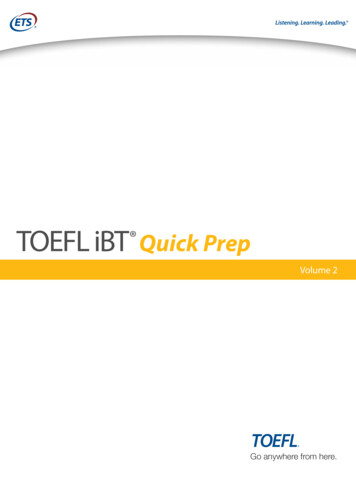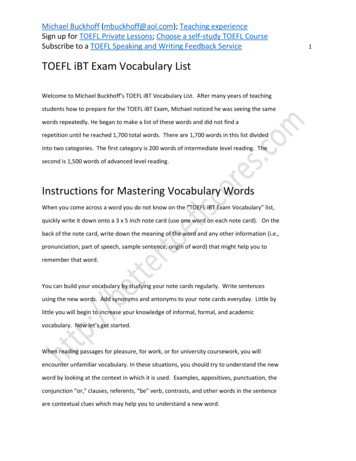
Transcription
GCC/IBT/Labor InstitutePowered Industrial Trucks (PIT)Health andSafety Awareness TrainingCompiled by The Labor Institute and theGraphic Communications Conference of InternationalBrotherhood of Teamsters (GCC/IBT)OSHA Grant # SH-18793-09-60-F11Draft 1.3July 2009 2009 The Labor Institute
GCC/IBT/Labor InstitutePowered Industrial Truck (PIT)Health and Safety Awareness TrainingCompiled by The Labor Institute and theGraphic Communications Conference of International Brotherhood of Teamsters (GCC/IBT)Draft 1.3July 2009 2009 The Labor Institute
GCC/IBT PIT Health and Safety Awareness TrainingProject TeamPrincipal GCC-IBT Officersin Charge:Robert Lacey, GCC/IBT International Vice PresidentGrant Director:Joe Anderson, The Labor InstituteTraining and CurriculumDirector:Les Leopold, The Labor InstituteTraining and CurriculumAssociate Director:Paul Renner, The Labor InstituteCurriculum Writer/Training and EvaluationCoordinator:Kathy Burris, The Labor InstituteCurriculum Development and AdaptationCoordination, Adaptation, Trainingand Support Team (CATS):Gene Binda and Rob Theisen, of GCC/IBT;Joe Anderson, Paul Renner and Kathy Burrisof The Labor InstituteResearch Director:David Dembo, Council on International andPublic AffairsChief Medical Advisor:Dr. Steven Markowitz, Mt. Sinai School of MedicineDesktop Publishing:Jean Urano, The Labor InstituteThis book is written and produced by The Labor Institute, a nonprofit organization (36East 12th Street, Suite 702, New York, NY 10003, 917-606-0511), and the GraphicCommunication Conference of the International Brotherhood of Teamsters (1900 L Street,NW, Washington, D.C. 20036-5007, 202-462-1400). The primary structure, writing, editing,layout and illustration are the responsibility of The Labor Institute staff, members of theUSW-United Steelworkers, USW Local 4-149.This material was produced under grant number SH-18793-09-60-F11 from theOccupational Safety and Health Administration, U.S. Department of Labor. It doesnot necessarily reflect the views or policies of the U.S. Department of Labor, nor doesmention of trade names, commercial products or organizations imply endorsement by theU.S. Government.ii
GCC/IBT PIT Health and Safety AwarenessTrainingTable of ContentsIntroduction1Activity 1: Hazards of Powered IndustrialTrucks (PIT)(2 tasks)7Activity 2: Mapping Hazards at Work (2 tasks)27Activity 3: Systems of Safety43(3 tasks)Activity 4: Identifying Near-Misses (3 tasks)63Activity 5: Incident Investigation using the Logic Tree(2 tasks)79Activity 6: Lessons Learned (3 tasks)101Activity 7: The OSHA Standard, 1910.178 PoweredIndustrial Trucks (1 task)121Appendix A: Safety Inspection Form, PIT and ForkliftsA-1Appendix B: Clarification regarding the policy for the use ofseat belts on PIT in general industryB-1Appendix C: Interpretive LetterC-1iii
GCC/IBT PIT Health and Safety Awareness Trainingiv
IntroductionWhy Is This Training Taking Place?The Graphic Communications Conference of the InternationalBrotherhood of Teamsters (GCC/IBT), in cooperation with TheLabor Institute of New York, received a training grant from the U. S.Department of Labor’s Occupational Safety and HealthAdministration (OSHA). OSHA announced a request for grantapplications under its Susan Harwood Training Grant Program.GCC-IBT and The Labor Institute successfully applied for a grant totrain workers and employers in Powered Industrial Truck safety inhigh hazard worksites as identified by OSHA and represented bythe Graphic Communications Conference of International Brother ofTeamsters. This grant was awarded in April 2009.To accomplish these goals, GCC/IBT workers will be trained astrainers to train their peers, their managers and other workers inhazard awareness and prevention based on a Systems of Safetyphilosophy and perspective.More about this TrainingThis workbook provides an overview of multiple ways to identifyhazards and some ideas for actions to correct these identifiedhazards. The examples in this workbook are not comprehensive.Anyone interested in more comprehensive training in these hazardidentification mechanisms should contact the GCC/IBT throughRobert Theisen at ggai@ggai.com, or the Labor Institute’s ProjectDirector Joe Anderson at joelwest@aol.com.This GCC/IBT/LI Powered Industrial Trucks training grant alsoprovides PIT certification training for operators using a separatetraining workbook. For information on certification training contactthe GCC/IBT through Rob Theisen at ggai@ggai.com or The LaborInstitute through Joe Anderson at joeliwest@aol.com.continued1
IntroductionGCC/IBT PIT Health and Safety AwarenessTrainingMore about this Training (continued)The information contained in this workbook comes from manysources. Activity 5: Lessons Learned, is an idea, and in part orwhole adapted from materials produced by The Labor Institute andthe United Steelworkers International Union under grant number46DO-HT11 Susan Harwood Training Grant Program.2
GCC/IBT PIT Health and Safety AwarenessTrainingIntroductionWorker-TrainersThe Labor Institute has a long history of involvement with healthand safety efforts and training. It is our belief that ourmembership is really the best resource for making our facilitiessafe and for protecting the community from harm.Together with GCC/IBT we are putting that belief into practice.That is why the GCC/IBT/Labor Institute* program is committed toconducting the training by GCC/IBT rank-and-file worker-trainers.In addition, the training will be done using a non-lecture approach,called the Small Group Activity Method, through which workerstruly participate in their own education.The average time a task takes to be worked through is 20 to 35minutes. Activities have at least one task, sometimes more. Anormal training day is eight hours, which is about five Activitiesincluding breaks and lunch.* The Labor Institute is a nonprofit educational group, located in New York City, that providesinnovative worker-oriented educational programs to unions and community groups around thecountry. The staff of the The Labor Institute are dues-paying members of USW Local 4-149.3
IntroductionGCC/IBT PIT Health and Safety AwarenessTrainingThe Small Group Activity Method (SGAM)The training activities in this workbook use the Small GroupActivity Method.Why a Non-Lecture Approach?Worker-oriented educators have learned the hard way that workingadults learn best in situations that maximize active participation andinvolvement. The trainer-centered, lecture-style teaching methodsused in most programs actually hurt the learning process, promotepassivity on the part of workers, de-value our knowledge and skillsand make us feel inadequate. As we all know, too many lectures“go in one ear and out the other.”The Small Group Activity Method puts the learner in the center ofthe workshop. Participants are put to work in the workshop solvingreal-life problems, building upon our own skills and experiences.Instead of learning by listening, as we are expected to do in alecture-style course, we learn by doing.OriginsThe Small Group Activity Method is based on a training proceduredeveloped by England's Trade Union Congress (TUC). (The TUC isthe organizational equivalent of the AFL-CIO.) The TUC used thisparticipatory, non-lecture method to train over 250,000 shopstewards on health and safety issues in the 1970s and early 1980s.The Labor Institute in New York, which had pioneered a similarmethod around economic issues for workers, further developed theprocedure into the Small Group Activity Method.Through the use of this non-lecture approach, The Labor Institutehas succeeded in training workers to be trainers. Since 1980, TheLabor Institute has shared this method with over 200 differentunions and community groups in the United States and Canada.*4
GCC/IBT PIT Health and Safety AwarenessTrainingIntroductionBasic StructureThe Small Group Activity Method is based on Activities. AnActivity can take from 30 minutes to an hour. Each Activity has acommon basic structure: Small Group Tasks Report-Back Summary1. Small Group Tasks: The workshop always operates with peopleworking in groups at tables. (Round tables are preferable.) EachActivity has a task, or set of tasks, for the groups to work on. Theidea is to work together, not to compete. Very often there is no oneright answer. The tasks require that the groups use their experienceto tackle problems and make judgments on key issues. Part of thetask often includes looking at factsheets and reading short handouts.2. Report-Back: For each task, the group selects a scribe whose jobit is to take notes on the small group discussion and report back tothe workshop as a whole. (The report-back person was first calledthe “scribe” by an OCAW worker-trainer during a 1982 session withMerck stewards in New Jersey.) During the report-back, the scribeinforms the entire workshop on how his or her group tackled theparticular problem. The trainer records these reports on large padsof paper in front of the workshop so that all can refer to it. After thescribe’s report, the workshop is thrown open to general discussionabout the problem at hand.3. Summary: Before the discussion drifts too far and wide, thetrainer needs to bring it all together during the summary. Here, thetrainer highlights the key points, and brings up any problems andpoints that may have been overlooked in the report-back. Goodsummaries tend to be short and to the point.continued5
IntroductionGCC-IBT PIT Health and Safety AwarenessTrainingThe Small Group Activity Method (SGAM)Three Basic Learning ExchangesThe Small Group Activity Method is based on the idea that everyworkshop is a place where learning is shared. With SGAM, learningis not a one-way street which runs from trainer to worker. Nor isSGAM simply a bull-session where we all sit around and talk.Rather, SGAM is a structured procedure that allows us to shareinformation. It is based on three learning exchanges: Worker to Worker Worker to Trainer Trainer to WorkerWorker to Worker: Most of us learn best from each other. Weshould never underestimate how much real education takes placeworker to worker. SGAM is set up in such a way as to make thisworker-to-worker learning exchange a key element of all of ourworkshops. We do this by first allowing people to learn from eachother by solving problems in their small groups.Worker to Trainer: Lecture-style training assumes that the trainerknows all the answers. SGAM believes that trainers also have a lotto learn. On many subjects, any group of workers will often have asmuch, or more, collective knowledge as any one expert or teacher.With SGAM the trick is to learn as much as possible from theworkshop participants. This is done mainly during the report-backs.Because SGAM allows us to listen to those we are training, we get tolearn more and more about the realities people face. Also, becauseour training method shows genuine respect for workers’ knowledge,it helps build confidence among those we are training. Confidenceis the key to adult learning.Trainer to Worker: This is the traditional learning procedure ofschool. It also has its place in SGAM. It comes at the end. This isour chance to clear up confusion and make the points we think arekey. By waiting until the summary section, we now know betterwhat people need to know.6
Activity 1: Hazards of PoweredIndustrial Trucks (PIT)PurposeTo identify potential Powered Industrial Trucks (PIT) hazards atour workplaces.This Activity has two tasks.7
GCC/IBT PIT Health and Safety Awareness TrainingActivity 1: Hazards of Powered Industrial Trucks (PIT)THISPINTENT AGELEF IONATBLL A N LYK8
GCC/IBT PIT Health and Safety Awareness TrainingActivity 1: Hazards of Powered Industrial Trucks (PIT)Task 1Pick a scribe at your tables to record your answers and report back tothe larger group.The chart below lists some common hazards associated withforklifts. There is a column of percentages randomly listed next tothe hazards.Based on your work experience, draw a line to connect the overallpercentage of incidents to the appropriate incidents.Overall percentageof PIT IncidentsSome Common Forklift or PITIncidents and Accidents14%Pedestrians injured by PIT’s18%Rollovers3%Load and falling debris26%Workers unaware of PIT danger arestruck by PITs14%Lifting people35%Improper training9
Activity 1: Hazards of Powered Industrial Trucks (PIT)GCC/IBT PIT Health and Safety Awareness TrainingTask 2Factsheet Reading Method for Task 2:The Small Group Activity Method places workers at the center of thelearning experience. It is designed to draw on two bodies ofknowledge: 1) The knowledge and experiences workers bring into theroom and 2) the factsheets contained in your workbooks.The factsheet method, described below, builds upon your knowledgethrough the introduction of new ideas and concepts.The process is as follows:Each of you will be assigned a small number of factsheets to read. Youwill then share this new information with your table.The idea is for each of you to take ownership and responsibility for theinformation contained in your factsheets and to describe it to the othersin your group.Factsheets will be assigned as follows:Starting with the scribe and moving to the left, count out loud from 1 to11. Keep going around the table until all numbers (factsheets) aredistributed. For example, if there are four people at your table, thescribe will have self-assigned Factsheets 1, 5 and 9, the person to theirleft will be responsible for Factsheets 2, 6 and 10, etc. The numbers thatyou have assigned yourself correspond to Factsheets 1 through 11 onpages 11 through 22.Once everyone has read their assigned factsheets, your scribe will goaround the table and ask each of you to explain to the rest of yourgroup what you have learned. No notes need be taken during thisdiscussion. The factsheets should be explained in order as they wereassigned (1 through 11), as many times factsheets build on previousfactsheets. Once this process is complete, your trainer will read thescenario and the task. In this way we all start at the same place andwith the same information.10
GCC-IBT PIT Health and Safety Awareness TrainingActivity 1: Hazards of Powered Industrial Trucks (PIT)1. Being a Pedestrian Can Be Dangerous According to a detailed study of fork-lift incidents published inthe American Journal of Industrial Medicine, “the most commonincident involved pedestrians (35%) who were struck by a PIT, orthe load being carried by a PIT, or a rack or bin that had beenstruck by a PIT.” A study of the U.S. auto industry reviewed 916 injuries from PITincidents over a three-year period in a variety of automobile facilities including assembly, stamping, parts and warehouses.Remarkably, they found that more than a third of the incidents(322), involved pedestrians.Source: Injuries Related to Forklifts and Other Powered Industrial Trucks in Automobile Manufacturing"authored by James W. Collins, Gordon S. Smith, Susan P. Baker and Margaret Warner.11
GCC/IBT PIT Health and Safety Awareness TrainingActivity 1: Hazards of Powered Industrial Trucks (PIT)2. Forklift Accidents Are much too CommonPowered industrial accidents cause approximately 100 fatalities and36,340 serious injuries in general industry and construction.120868911495Source: t/slide9.html12
GCC/IBT PIT Health and Safety Awareness TrainingActivity 1: Hazards of Powered Industrial Trucks (PIT)3. The PIT Stability Triangle: Your Key toSafe OperationsMost PITs have a three-point suspension system. The vehicle is supportedat three points. This is true even if the vehicle has four wheels. The truckssteer axle is attached to the truck by a pivot pin in the axle’s center. Whenthe points are connected with imaginary lines, this three-point supportforms a triangle called the stability triangle.continued13
Activity 1: Hazards of Powered Industrial Trucks (PIT)GCC/IBT PIT Health and Safety Awareness Training3. The PIT Stability Triangle: Your Key toSafe Operations (continued)When the vehicles load center falls within the stability triangle, thevehicle is stable and will not tip over. When the line of action or thevehicle/load center combination falls outside the stability triangle, thevehicle is unstable and may tip over.See Appendix A (page 142) for more detailed information.Source: Powered industrial trucks. – 1910.178 App A.14
GCC/IBT PIT Health and Safety Awareness TrainingActivity 1: Hazards of Powered Industrial Trucks (PIT)4. Rollovers DangersA full 26% of forklift accidents are the result of a lift tipping over. Liftsshould have a “roll over protection system” which will prevent thedriver from being thrown and crushed in case the lift tips or falls over.Sometimes serious injury or death is incurred when a lift tips becausethe seats of the vehicle arepoorly designed. The seatsshould be constructed witharm rests and shoulder extensions that prevent theoperator from being ejectedout of the seat or slidingsideways in when anaccident occurs. Thereshould also be “GrabHandles” in the operator’scompartment so that one canbrace himself if the lift startsto tip. In some cases a poorlymaintained forklift won'thave seat belts.It is a proper safety precaution to always wear seat belts whenoperating a PIT if they are installed equipment or when retrofitted bythe manufacturer (See Appendix B for further clarification orhttp://www.osha.gov/pls/oshaweb/owadisp.show document?p table INTERPRETATIONS&p id 22315). If manufacturer retrofitting ismade available for a PIT without a seatbelt and the employer fails totake advantage of this offer, this maybe an OSHA violation.1910.178(q)(7): industrial trucks shall be examined before being placedin service, and shall not be placed in service if the examination showsany condition adversely affecting the safety of the vehicle. Such examination should be made at least daily.Source: t accidents.html.15
Activity 1: Hazards of Powered Industrial Trucks (PIT)GCC/IBT PIT Health and Safety Awareness Training5. Load and Falling Debris from PITs Cause InjuriesFourteen percent of forklift accidents are the result of a load or otherdebris falling on a worker. The forklift should have a “All FallingObject Protection System” that completely protects the operator fromfalling objects. Sometimes these accidents happen because the forkdoes not have “back rest extensions” allowing the load to fall overthe top of the extended mast. Forks should be equipped with “Backrest extensions.”Source: t accidents.html.16
GCC/IBT PIT Health and Safety Awareness TrainingActivity 1: Hazards of Powered Industrial Trucks (PIT)6. Pedestrians Beware: Maintenance, Inspection andWarning Devices are CriticalEighteen percent of forklift accidents occur when a walking employeeor other pedestrians are struck by a lift, often because they are busywith other tasks and not fully aware of a lift operating nearby. Thebest pedestrian designated walkways are those that have strongphysical barriers between the walkway and the forktruck right of way.Lifts should be equipped with automatic signal alarms that soundduring operation so that those nearby are aware of its location. Oftenthis type of accident occurs because a poorly maintained lift does nothave very basic safety features such as rear view mirrors.It is also the responsibilityof the employer to set upan inspection and maintenance program. In everyworkplace that uses liftsthere should be a set ofoperation rules posted inplain view. Maintenanceand inspection should bedone on a regular basisto prevent problems.There are hazardsassociated with lack ofmaintenance and inspection such as potential equipment malfunctionthat could cause dangers to the operators and those in the area.Warning devices on a lift fail if they are not inspected and maintained.Improperly maintained PIT internal combustion engines cause significant air quality issues, and there are hazards inherent to maintaininglarge heavy PIT machines including toxic solvents used internally withPITs as well as for maintenance.Source: t accidents.html.17
Activity 1: Hazards of Powered Industrial Trucks (PIT)GCC/IBT PIT Health and Safety Awareness Training7. Don’t Lift PeopleFourteen percent of forklift accidents occur because the lift is inappropriately used to elevate workers.Interpretations of the construction PIT standards and other OSHAinterpretations provide specific language for the lifting personnelprovided the equipment specifically allows for the use of a platformdesigned for this purpose. If the allowable proper equipment isproperly installed and operated lifting personnel with a PIT is allowed.See Appendix C for the interpretive letter.We suggest using equipment that is specifically designed for liftingpersonnel and provides control of the lift to the person or personsbeing lifted.Source: t accidents.html.18
GCC/IBT PIT Health and Safety Awareness TrainingActivity 1: Hazards of Powered Industrial Trucks (PIT)8. It is Dangerous to Operate PITs if notProperly TrainedThree percent of forklift accidents occur because the operator lostcontrol of the vehicle. Sometimes these accidents occur becauseemployees are asked to operate when they have not been properlytrained. OSHA has a standard training and evaluation program that allforklift operators must complete before they are can operate. If anoperator has not been adequately trained and evaluated according tothese guidelines, the employer can be found negligent. It is theemployer’s responsibility to notify untrained and unlicensed employeesthat forklifts are off limits.Source: t accidents.html.19
Activity 1: Hazards of Powered Industrial Trucks (PIT)GCC/IBT PIT Health and Safety Awareness Training9. PITs Accidents and Unexpected HazardsAccidents happen and in the case of forklifts and PITs the result ofthese accidents can have some unforeseen hazardous consequences. Forklifts can pierce drums containing hazardous solventschemicals causing a toxic release or a flammable hazard. Small nicks or holes in liquid containers placed in a the way ofPIT's can be made to leak by contact and cause slipping hazards. Strong acids (such as sulfuric acid) are used in batteries. Makesure you are properly protected if you are required to work withacids. To prevent injury: Wear protective clothing such as rubber boots, a rubberapron, chemical goggles, face shields, and rubber glovesto guard against chemical splashes and burns.Know where the closest available eye wash stations arelocated. When charging batteries, acid should be poured into water;water should not be poured into acid. (This may result inan explosion.) PITs should only be used in hazardous atmosphereswhere they are designed and approved for use. Reference thestandard in the Appendix, 1910.178(c)(2)(iv) Table N1, page 127for appropriately designed PITs for specific hazardous conditions.Source: http://www.nycosh.org/workplace hazards/Forklift%20Fact%20Sheet.html.20
GCC/IBT PIT Health and Safety Awareness TrainingActivity 1: Hazards of Powered Industrial Trucks (PIT)10. Maintenance and Operation of Propane TrucksExtra precautions need to be taken with trucks powered by propane orliquefied petroleum gas (all of which are discussed in the regulation):Always check for gas leaks. Never start the motor if thereis a leak.Don’t store the truck near intense heat or explosive materials.If the truck is to be left standing for any length of time, shut offthe hand valve and let the fuel system run dry.Source: http://www.nycosh.org/workplace hazards/Forklift%20Fact%20Sheet.html.21
Activity 1: Hazards of Powered Industrial Trucks (PIT)GCC/IBT PIT Health and Safety Awareness Training11. Tips for Forklift Operators In stockrooms, double-acting doors should have windowsinstalled to minimize the possibility of employees being struck bya powered industrial truck, particularly forklifts. Signal hornbefore entering doorway. Whether loaded or empty, carry forks and platforms on lift trucksas low as possible. This reduces the possibility of overturning thetruck or dumping the load. Loads should not be raised or lowered during travel. Internalcombustion-powered trucks should never be used in smallbuildings or areas where there is inadequate ventilation. Wheels, high-lift platform rollers, chain sprockets and othermoving parts should be guarded if they can potentially injure theoperator or others.Source: http://www.nycosh.org/workplace hazards/Forklift%20Fact%20Sheet.html.22
GCC/IBT PIT Health and Safety Awareness TrainingActivity 1: Hazards of Powered Industrial Trucks (PIT)Task 2 (continued)Purpose restated: To identify potential Powered Industrial Trucks(PIT) hazards at our workplaces.1. Reviewing your answers to Task 1 are there any percentages youwant to change? Were you surprised by that?Be prepared to report your answers to the large group.2. What is the most common forklift or PIT accident in yourworkplace? Make a list and report back to the group23
Activity 1: Hazards of Powered Industrial Trucks (PIT)GCC/IBT PIT Health and Safety Awareness TrainingSummary: Hazards of Powered IndustrialTrucks (PIT)1. PITs are necessary for our work at most workplaces.2. Identifying hazards created by the use of PITs is the first step topreventing workplace accidents and injuries.3. Powered industrial truck accidents cause approximately 100fatalities and 36,340 serious injuries in general industry andconstruction annually.4. PIT hazards affect more that just the operator: Pedestrians are in danger; There are other PIT hazards such as air quality, slipping hazards,falling loads; and Maintenance and inspection can be hazardous work.24
GCC/IBT PIT Health and Safety Awareness TrainingActivity 1: Hazards of Powered Industrial Trucks (PIT)Activity 1: Hazards of Powered IndustrialTrucks (PIT)EVALUATION1. How important is this Activity for workers? Please circleone number.Activity Is Not Important1Activity Is Very Important23452. Which factsheets are the most important to distribute to theworkers? (Please list the page numbers.)3. What would you suggest be done to improve this Activity?25
Activity 1: Hazards of Powered Industrial TrucksTHISPINTENT AGELEF IONATBLL A N LYK26GCC/IBT PIT Health and Safety Awareness Training
Activity 2: Mapping Hazards at WorkPurposeTo learn how to develop a Hazard Map that workers can use toidentify and locate hazards so that those hazards can be targetedfor elimination.This Activity has two tasks.27
Activity 2: Mapping Hazards at WorkGCC/IBT PIT Health and Safety Awareness TrainingTask 1Factsheet Reading Method for Task 1:The Small Group Activity Method places workers at the center of thelearning experience. It is designed to draw on two bodies ofknowledge: 1) The knowledge and experiences workers bring into theroom and 2) the factsheets contained in your workbooks.The factsheet method, described below, builds upon this knowledgethrough the introduction of new ideas and concepts.The process is as follows:Each of you will be assigned a small number of factsheets to read. Youwill then share this new information with your table.The idea is for each of you to take ownership and responsibility for theinformation contained in your factsheets and to describe it to the othersin your group.Factsheets will be assigned as follows:Starting with the scribe and moving to the left, count out loud from 1 to6. Keep going around the table until all numbers (factsheets) aredistributed. For example, if there are four people at your table, thescribe will have self-assigned Factsheets 1 and 5, the person to their leftwill be responsible for Factsheets 2 and 6, etc. The numbers that youhave assigned yourself correspond to Factsheets 1 through 6 on pages29 through 35.Once everyone has read their assigned factsheets, your scribe will goaround the table and ask each of you to explain to the rest of yourgroup what you have learned. No notes need be taken during thisdiscussion. The factsheets should be explained in order as they wereassigned (1 through 6), as many times factsheets build on previousfactsheets. Once this process is complete, your trainer will read thescenario and the task. In this way we all start at the same place andwith the same information.28
GCC/IBT PIT Health and Safety Awareness TrainingActivity 2: Mapping Hazards at Work1. Using Hazard Mapping to Identify Possible RisksA Hazard Map is a visual representation of the workplacewhere there are hazards that could cause injuries or illness.The Hazard Mapping method draws on what workers know from onthe-job experience. The Hazard Mapping approach is best whenconducted with a small group of workers with some similarity in theirwork. For example, a group of workers who do work in the same typeof workplace or a group of maintenance workers who all worked inseveral buildings but do the same kind of work.29
Activity 2: Mapping Hazards at WorkGCC/IBT PIT Health and Safety Awareness Training2. Using Hazard Mapping to Identify Area-WideHazards or Hazards in Specific Areas of WorkThe Hazard Mapping process can be used to identify risks at a largeworkplace and to specify hazards associated with an AREA,BUILDING, JOB CLASSIFICATION or PROCESS.After completing the large workplace map, it may be obvious that amore detailed map of certain areas or buildings would be helpful in“narrowing down” the processes, areas or jobs that have moredangerous hazards or where worker exposures to hazards are greatest.For example hazard maps might target: Physical Hazards; Frequency of Exposure; Level of Exposure; A Specific Chemical or Agent; or Work
This GCC/IBT/LI Powered Industrial Trucks training grant also provides PIT certification training for operators using a separate training workbook. For information on certification training contact the GCC/IBT through Rob Theisen at ggai@ggai.com or The Labor Institute through Joe Anderson at joeliwest@aol.com. continued 1










